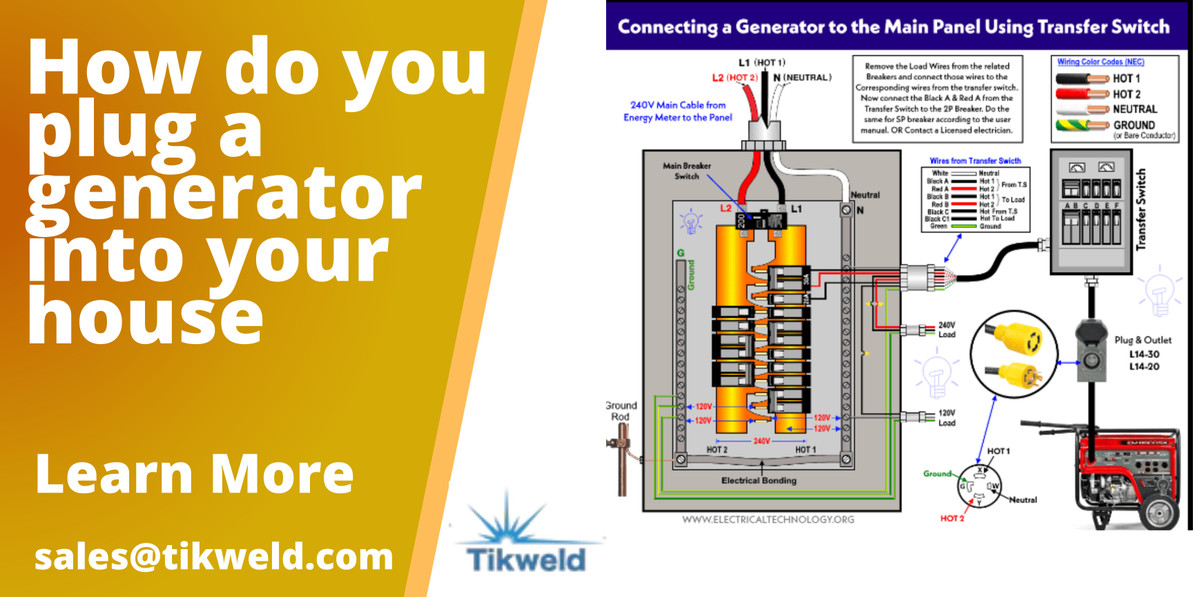Plugging a generator directly into a 220V outlet is not recommended. It poses safety risks and may damage your electrical system.
Understanding the complexities of powering your home during an outage is crucial. Generators are invaluable during power outages, providing the necessary electricity to keep essential appliances running. Yet, their safe operation requires adherence to specific guidelines. Directly connecting a generator to a home’s electrical system without proper equipment can lead to hazardous situations, including electrical fires or electrocution.
It’s important to use a generator safely to ensure not only the protection of your electrical devices but also the safety of your home and family. Safe practices include using a transfer switch or consulting with a professional electrician. This ensures that the generator is correctly integrated into your home’s power system, minimizing risks and ensuring the safety of everyone involved.
Introduction To Generator Connections
Understanding how to connect a generator safely is key. Many people wonder about plugging a generator directly into a 220V outlet. This section explores the essentials of generator connections and safety measures.
The Basics Of Generator Power
Generators provide electricity during outages. They need correct connections to power homes. Let’s look at the basics:
- Voltage compatibility is crucial for safe operation.
- Generators have different outlet types for various needs.
- Directly plugging into a 220V outlet requires caution.
Safety Considerations
Safety is the most important aspect of using generators. Here are some tips:
- Always read the manual before attempting connections.
- Use proper cords that can handle the generator’s output.
- Never backfeed power without a transfer switch.
- Ensure the generator is in a well-ventilated area.
Types Of Generator Outlets
Understanding the different types of generator outlets is crucial. It ensures safe and efficient power delivery. Let’s dive into the common configurations and specifics for 220V outlets.
Common Outlet Configurations
Generators come with various outlet types. Each serves a different power need. Know these to match your equipment correctly.
- 120V Outlets: Common for small appliances.
- 240V Outlets: Needed for heavy-duty tools.
- RV Outlets: Specialized for recreational vehicles.
- GFCI Outlets: Ground-fault circuit interrupters for safety.
- Twist-Lock Outlets: Secure connections for outdoor use.
220v Outlets And Generators
Plugging a generator into a 220V outlet requires care. Follow these steps:
- Check your generator’s manual for compatibility.
- Use the correct adapter if needed.
- Ensure your generator can handle the load.
- Never backfeed power without a transfer switch.
Remember, safety is key. Consult a professional electrician when in doubt.
Understanding Electrical Voltage
Voltage is key in powering devices. It’s like water pressure in pipes. Homes usually have 110V or 220V outlets. Using the right voltage is crucial for safety and device performance.
Voltage Requirements
Each appliance has a voltage requirement. This must match the outlet. Plugging into the correct voltage ensures safety. It also guarantees the appliance works as expected.
- Check appliance labels for voltage.
- Match generator output with device needs.
- Use a converter if voltage differs.
Differences Between 110v And 220v
| 110V | 220V |
|---|---|
| Common in North America. | Standard in Europe, Asia. |
| For smaller appliances. | For heavy-duty devices. |
| Less energy transfer. | More efficient for large appliances. |
Generators often offer both 110V and 220V outlets. Plugging a generator into a 220V outlet requires caution. Ensure it matches your power needs. Always follow the manufacturer’s guidelines.

Credit: m.youtube.com
The Role Of Transfer Switches
Understanding the role of transfer switches is crucial for safe generator use. These devices ensure a secure and efficient connection to your home’s power system. Let’s delve into what transfer switches are and why they are important.
What Is A Transfer Switch?
A transfer switch is a device that safely connects a generator to your home’s electrical panel. It prevents electricity from the generator from going back onto the utility lines. This protection is vital for the safety of utility workers and your home. Transfer switches can be manual or automatic.
- Manual Transfer Switches require you to manually switch the power source from the utility to the generator.
- Automatic Transfer Switches automatically switch to generator power when the utility power fails.
Why Use A Transfer Switch?
Using a transfer switch with your generator has several benefits:
- Safety: It ensures that generator power does not back-feed into utility lines, protecting utility workers.
- Convenience: Automatic switches provide immediate power during outages without manual intervention.
- Compliance: Most local codes require a transfer switch for generators connected to home wiring.
Remember, plugging a generator directly into a 220V outlet without a transfer switch is dangerous. It risks back-feeding, overloading, and can harm your electrical system. Always use a transfer switch to connect your generator safely.
Can You Plug Directly Into A 220v Outlet?
Many people wonder, can you plug directly into a 220V outlet? This question is common when using generators. Let’s explore the details.
Direct Connection Risks
- Electrical overload: Too much power can harm devices.
- Safety hazards: Risks of fire or electrocution increase.
- Appliance damage: Wrong voltage can break your tools.
Plugging a generator into a 220V outlet without caution can be dangerous. It’s vital to understand the risks involved.
Appropriate Scenarios For Direct Plugging
However, in some cases, direct plugging is safe. Let’s see when:
- With proper tools: Use a transfer switch or interlock kit.
- Correct setup: Ensure the generator matches outlet specs.
- Professional advice: Always consult with an electrician first.
Direct connection to a 220V outlet is possible but needs care. Always prioritize safety and correct setup to avoid risks.
Step-by-step Guide To Connecting Generators
When it comes to using generators, safety and correct setup are key. This guide provides a clear path to connect your generator to a 220V outlet.
Preparation Steps
Before starting, gather all necessary items:
- Generator manual
- Appropriate cables
- Protective gear
Ensure the generator is off and cool. Check the outlet’s voltage matches your generator.
Executing The Connection
- Inspect the cables for damage.
- Wear gloves and eye protection.
- Position the generator outdoors away from windows.
- Plug in the cable to the generator.
- Connect the other end to the 220V outlet.
- Turn on the generator using the manual’s instructions.
Once connected, the generator should power your devices safely.
Troubleshooting Common Issues
Plugging a generator into a 220V outlet requires caution. Let’s troubleshoot common issues.
Overloading Concerns
Generators have limits. Pushing them too far risks damage. To avoid overloading:
- Check the generator’s capacity.
- Match it with your appliances’ total wattage.
- Never exceed the recommended load.
Use a wattage meter to monitor output. This ensures safety and longevity.
Addressing Connection Failures
Connection issues can arise. To fix them:
- Ensure the plug fits the outlet properly.
- Inspect the cord for damage.
- Check circuit breakers and reset if tripped.
If problems persist, consult a professional. They can provide guidance and repair services.

Credit: tikweld.com
Expert Tips For Safe Generator Use
Understanding how to use a generator safely is crucial. Plugging a generator into a 220V outlet needs caution. Follow expert guidelines to prevent hazards.
Maintenance Best Practices
Regular maintenance ensures generator reliability. Follow these steps for optimal performance:
- Check oil levels before each use.
- Clean or replace air filters every 100 hours.
- Inspect spark plugs for wear and tear.
- Run the generator every three months to prevent fuel issues.
Long-term Storage Advice
Storing your generator correctly extends its life. Use these tips when not in use:
- Drain fuel to avoid gum and varnish buildup.
- Use fuel stabilizer if storing with gasoline.
- Store in a cool, dry place to prevent corrosion.
- Disconnect battery terminals if applicable.
Local Codes And Regulations
Dealing with electricity requires caution. It’s vital to follow local codes and regulations when considering plugging a generator into a 220V outlet. These rules ensure safety and compliance. Let’s explore the specifics of electrical codes and when to call an electrician.
Understanding Your Area’s Electrical Codes
Electrical codes vary by location. These codes govern the installation and operation of electrical systems, including generators. Adhering to these standards is not optional; it’s a legal requirement. Non-compliance can lead to serious consequences, like fines or electrical fires.
- Check with your city or county building department.
- Review the National Electrical Code (NEC) as a baseline.
- Understand amendments or additional requirements in your area.
Not all outlets are the same. A 220V outlet typically serves high-powered appliances. Plugging a generator directly into such an outlet without proper protocol can be dangerous. Ensure your actions meet local electrical codes.
When To Consult A Professional Electrician
Electrical work often needs expert hands. If you are unsure about the process or regulations, seek a professional electrician. They have the experience and training to handle high-voltage tasks safely.
- A professional can assess your generator and outlet compatibility.
- They ensure safe and compliant installation.
- Electricians can obtain necessary permits or inspections.
Before plugging in a generator, consider the complexity of electrical systems. A licensed electrician can provide peace of mind. They make sure everything operates within the confines of local codes.

Credit: m.youtube.com
Alternative Power Solutions
Exploring alternative power solutions is essential for modern living. Whether due to unexpected outages or planned maintenance, having a reliable backup plan is key. Let’s dive into the options available beyond plugging a generator into a 220V outlet.
Backup Power Systems
A secure backup power system ensures uninterrupted electricity. Think of it as a safety net for your home or business. There are several types to consider:
- Uninterruptible Power Supplies (UPS): Perfect for short-term outages, keeping devices running smoothly.
- Portable Generators: Ideal for immediate, on-the-go power needs; just fill with fuel and start.
- Standby Generators: Automatically kick in when power cuts, offering longer-term solutions.
Renewable Energy Options
Renewable energy brings sustainability to the forefront. These systems not only provide power but also reduce carbon footprints. Consider these popular choices:
- Solar Panels: Capture sunlight and convert it into electricity; great for homes and businesses.
- Wind Turbines: Generate power through wind; suitable for areas with consistent wind patterns.
- Hybrid Systems: Combine solar and wind for a robust, all-weather solution.
Choosing the right alternative power solution depends on individual needs and environmental conditions. Always consult with a professional before making significant changes to your power setup.
Conclusion: Ensuring Safety And Efficiency
Conclusion: Ensuring Safety and Efficiency ties up the discussion on connecting generators to 220V outlets. Let’s recap and offer final thoughts.
Recap Of Key Points
- Never plug a generator directly into a 220V outlet.
- Use a transfer switch for safe operation.
- Ensure the generator matches the outlet’s voltage.
- Follow the manual’s instructions strictly.
- Regular maintenance keeps the generator efficient.
Final Thoughts On Generator Use
Using a generator requires care and knowledge. Safety comes first, both for people and equipment. A transfer switch is essential. It protects against backfeeding, which can cause severe hazards. Always consult professionals for installation and maintenance. This ensures a safe and efficient power source during outages.
Frequently Asked Questions
Can You Safely Connect Generators To 220v Outlets?
Generators can be connected to 220V outlets, but it must be done safely using the appropriate transfer switch and connectors to prevent backfeeding and ensure compliance with local electrical codes.
What’s Needed To Plug A Generator Into 220v?
To plug a generator into a 220V outlet, you need a transfer switch, the correct adapter, and potentially a professional electrician to ensure a safe and code-compliant setup.
Are All Generators Compatible With 220v Outlets?
Not all generators are compatible with 220V outlets. Check the generator’s specifications for voltage compatibility and necessary connections before attempting to plug it in.
How To Prevent Backfeeding From Generators?
Prevent backfeeding by using a transfer switch when connecting a generator to a home circuit. This isolates the generator’s power from the main grid and protects utility workers.
What Are The Risks Of Improper Generator Connection?
Improper generator connection can lead to electrical hazards, including backfeeding, fire risks, damage to appliances, and potentially fatal electric shocks. Always follow safety guidelines.
Conclusion
Wrapping up, connecting a generator to a 220V outlet requires caution. Always prioritize safety and consult a professional electrician. Remember, proper steps ensure effective and hazard-free operation. Your preparedness can make all the difference during power outages. Choose wisely, stay informed, and power on.




